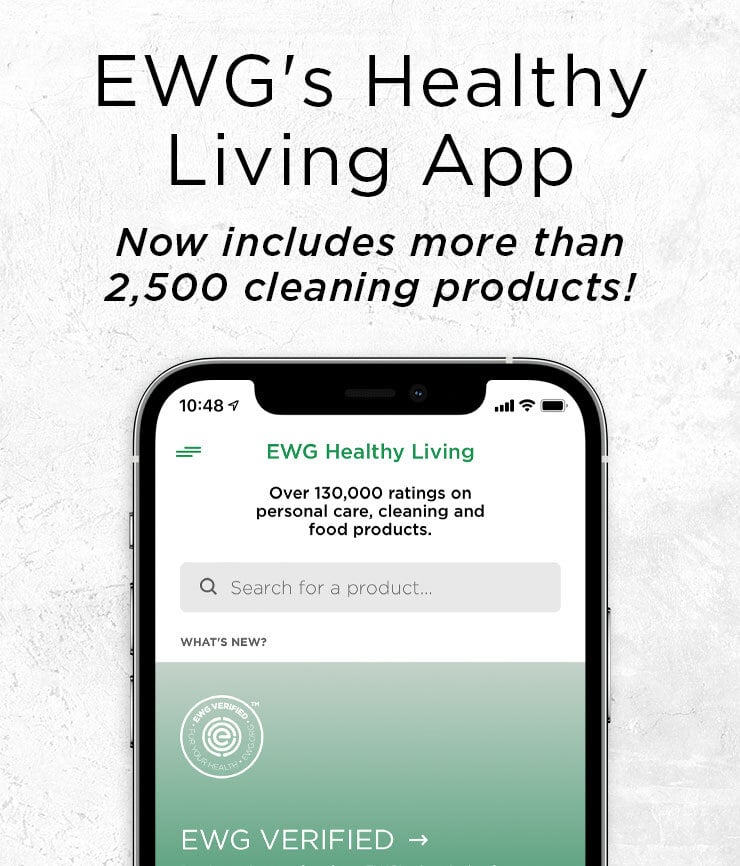Apples doused with chemical after harvest
WEDNESDAY, MARCH 20, 2019
Apples are generally near the top of EWG’s Dirty Dozen™ list because they contain an average of 4.4 pesticide residues, including some at high concentrations. One chemical found on apples has triggered an intense international debate, set the U.S. and Europe on radically different courses, and given Americans one more reason to buy organic apples.
Few Americans may realize it, but most conventionally grown apples are drenched in diphenylamine, an antioxidant chemical treatment used to prevent the skin of apples in cold storage from developing brown or black patches known as “storage scald.” Tests of raw apples conducted by Department of Agriculture scientists in 2016, the most recent year for which data are available, found diphenylamine on 80 percent of them, with an average concentration of 0.28 parts per million.1
American apple growers contend that diphenylamine is a benign treatment. European officials, on the other hand, are not satisfied that it may be harmless and, beginning in 2014, enacted a restriction on imported apples and pears treated with the chemical.2
Since diphenylamine is sprayed on fruit after it is harvested, USDA tests of apples find it more often and at greater concentrations than they do most other pesticide residues. (Diphenylamine is regulated as a pesticide, but it does not kill insects, weeds or fungal growth.) Diphenylamine was also found in 36 percent of applesauce samples but at much lower concentrations.
The Environmental Protection Agency reviewed the safety of diphenylamine, in 1998, and concluded that its use posed no unacceptable risk to people or the environment.3 The agency updated its safety assessment in 2018 and concluded that the maximum concentrations of diphenylamine allowed on apples should remain at 10 parts per million.
By contrast, European regulators ascribe the absence of evidence of harm to poor investigation. They concluded diphenylamine manufacturers had not conducted enough tests to prove the safety of their product and any chemicals formed when it broke down.4
The European officials’ concerns center on the possible formation of nitrosamines on diphenylamine-treated fruit. Nitrosamines form when nitrogen-containing compounds combine with amines, like diphenylamine. Nitrosamines cause cancer in laboratory animals, and some studies have found that people who eat foods with nitrosamines have elevated rates of stomach and esophageal cancers.5
Since the 1970s, European government agencies have regulated foods and consumer products to limit concentrations of chemicals that can serve as building blocks of nitrosamines.
Since Americans eat on average more than 10 pounds of raw apples every year apiece,6 even low levels of nitrosamines on apples could pose a risk to human health.
European regulators theorized that nitrosamines could be generated if diphenylamine combined – either during storage or when fruit was processed – with a source of nitrogen, an element ubiquitous in the environment. But they had little evidence that this chemical reaction was, in fact, occurring. Beginning in 2008, they pressed the manufacturers of diphenylamine for data that showed whether nitrosamines or other harmful chemicals formed either when containers of diphenylamine sat on shelves, when fruit was treated with diphenylamine and stored for a long time, or when diphenylamine-treated fruit was processed into juices, purees and sauces.7
The industry provided one study that detected three unknown chemicals on diphenylamine-treated apples at concentrations greater than 50 parts per billion, but it could not determine whether any of these chemicals were nitrosamines. It did not study whether nitrosamines were being formed on diphenylamine-treated apples made into apple juice or applesauce.
In 2012 the European Food Safety Authority, the European body that evaluates the risk of pesticides, concluded that the industry had not provided sufficient information and that the many data gaps made it impossible to confirm the safety of diphenylamine. The EU reduced the allowable level of diphenylamine on imports to 0.1 part per million, or ppm.8
Europe set a temporary residue level of 0.1 ppm, which expired in 2018. The reason it did not set the permissible level of diphenylamine at zero was because untreated apples can sometimes acquire traces of diphenylamine even if they are merely stored in facilities that have held diphenylamine-coated apples. To avoid this type of cross-contamination, American growers that export apples and pears to Europe use special diphenylamine-free warehouses.
The EPA has taken few steps to respond to the European ban or EU concerns about nitrosamines. Its website states that a reregistration review is underway, and an interim decision will be published in 2019.
Until it is possible to determine the safety of diphenylamine, EWG recommends eating organic apples, apple juice, applesauce and pears to minimize the risk of ingesting nitrosamines and other potentially dangerous pesticide residues.
- USDA, Pesticide Data Program: Annual Summary, Calendar Year 2016. U.S. Department of Agriculture, February 2018.
- European Commission, European Commission Regulation No 772/2012, 8 August 2013, Amending Annexes II, III and V to Regulation (EC) No 396/2005 of the European Parliament and of the Council as Regards Maximum Residue Levels for Diphenylamine in or on Certain Products. Official Journal of the European Union, 2013, L 217/2. Available at eur-lex.europa.eu/LexUriServ/LexUriServ.do?uri=OJ:L:2013:217:0001:0027:EN:PDF
- EPA, Reregistration Eligibility Decision (RED) Diphenylamine. EPA738-R-97-010. Environmental Protection Agency, April 1998. Available at https://archive.epa.gov/pesticides/reregistration/web/pdf/2210red.pdf
- European Food Safety Authority, Conclusion on the Peer Review of the Pesticide Risk Assessment of the Active Substance Diphenylamine. EFSA Journal, 2012, 10(1):2486-2527.
- National Toxicology Program, N-nitrosamines. Report on Carcinogens, Fourteenth Edition, 2016. Available at ntp.niehs.nih.gov/ntp/roc/content/profiles/nitrosamines.pdf
- USDA, Food Availability and Consumption: Apples and Oranges Are America’s Top Fruit Choices, November 29, 2018. Available at www.ers.usda.gov/data-products/ag-and-food-statistics-charting-the-essentials/food-availability-and-consumption/
- European Food Safety Authority, Conclusion Regarding the Peer Review of the Pesticide Risk Assessment of the Active Substance Diphenylamine. EFSA Scientific Report, 2008, 188.
- European Commission, European Commission Regulation No 772/2012, 8 August 2013, Amending Annexes II, III and V to Regulation (EC) No 396/2005 of the European Parliament and of the Council as Regards Maximum Residue Levels for Diphenylamine in or on Certain Products. Official Journal of the European Union, 2013, L 217/2. Available at eur-lex.europa.eu/LexUriServ/LexUriServ.do?uri=OJ:L:2013:217:0001:0027:EN:PDF
Other EWG Resources

EWG's Tap Water Database

Children's Health Initiative

EWG's Healthy Living App

Guide to Healthy Cleaning

EWG's Food Scores

EWG's Skin Deep

Safe Cell Phone Use



 Skin Deep
Skin Deep
 Cancer Prevention Within Reach
Cancer Prevention Within Reach
 Shopper's Guide to Pesticides in Produce™
Shopper's Guide to Pesticides in Produce™
 Guide to Healthy Cleaning
Guide to Healthy Cleaning
 EWG's Tap Water Database
EWG's Tap Water Database
 Food Scores
Food Scores
